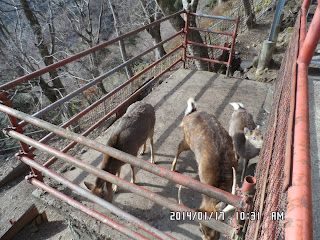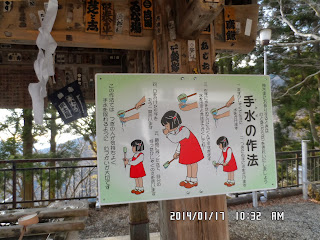Mountain: Mt. Ohyama (大山 오오야마 1,252m),
Date: January 17, 2014 (Fri) Cloudy
Course: Ohyama Cable Bus-Stop – Ohyama Cable Station – Shimosha – The Summit of Ohyama – Miharashi – Ohyama Cable Station – Bus Stop (About 8 km, 5 hours)
After climbing 4 mountains (Mt. Haguro, Mr. Kimbo, Mt. Hayama, Mt. Takao) I decided to climb Mt. Ohyama as my 5th hike for this year.
Mt. Ohyama has the altitude of 1,252m, and it has the main shrine of Aburi Shrine阿夫利神社 and the main temple, Ohyamadera Temple大山寺.
Besides these shrine and the temple, it also has many shrines and temples.
The mountain has been considered as a religious mountain, esp. since Edo period (1600 – 1868).
Another name of Ohyama is “Afurisan雨降山” which means “Rain Mountain.”
People who need “rain” badly are usually farmers and fire-fighters.
So esp. during dry weather, they climbed Mt. Ohyama and prayed the god for rain.
Just like Takaosan, the name of contributors were written with the amount of money they gave to the shrine on the memorial stones along the trail to the shrine.
Another similarity is the belief for “Tengu.” There was a memorial stone on which the statute of “Tengu天狗” was curved next to the “Shimosha Shrine下社".
Next to the “Tengu” stone, there was a shrine called “Tenmangu天満宮.”
Since Tenmangu enshrined “Sugawara MIchizane菅原道真” who is regarded as the god of academic achievement, many examinees, esp. for those who take entrance exams of universities, pay visit and pray for their success.
http://en.wikipedia.org/wiki/Tenman-g%C5%AB
Anyway, I left home at 8 am and headed for Isehara since it is the base station for Ohyama hikers.
I changed trains two times (at Fujisawa and Sagamiohno) and arrived at Isehara at 9 am.
From Isehara to the foot of Mount Ohyama, I took a bus. Then walked to the Ohyama Cable-Car Station.
Usually I do not take Cable-Car and walk either Otokozaka (男坂) or Onnazaka (女坂) to Shimosha Shrine of Afuri Shrine (阿夫利神社).
But this time, I used the cable-car since I used the cable-car at Mt. Takao, and wanted to compare with it.
There is "Ohyama Tourist Information" near the bus stop. Tourists and hikers can get information here for free.
From the bus-stop to the Cable-Car Station, there is a path between shops and stores on both side.
Along the path, I saw several arts such as "Ukiyoe" by Hokusai printed on tile wall.
The path from the bus stop to the cable car station, was well paved or made by tiles.
There was the blossoms of Chimonanthus or wintersweet along the path.
There was a big billboard advertising "Ohyama Top." Tops are traditional toys in Japan, and "Ohyama Top" is famous for its good quality.
Just like cable-cars at Takaosan, they use two cable-cars; “Tanzaga-gouたんざわ号” and “Ohyama-gou.おおやま号”
Comparing with Takaosan Cable-Car, Ohyama Cable-Car is newer. It was open in 1965.
http://en.wikipedia.org/wiki/%C5%8Cyama_Cable_Car
They operate every 20 minutes and I arrived at the station at 9:43, just after the one at 9:40 left.
Since I had a little time, I looked around the station carefully.
I noticed a small shrine in front of the station. It says “Nenomoto Shrine根之元神社."
There was a plate explaining the names of gods enshrined at this shrine.
They are as follows:
1) Iwasaku-no-kami
2) Nesaku-no-kami
3) Iwatutuio-no-kami
How they were produce are written in “Kojiki古事記”the oldest extant chronicle in Japan.
The story about these 3 gods is quite interesting to me, because I saw another shrine called “Haniyamahime Shine埴山姫神社” at Hagurosan羽黒山 on Jan. 2nd, this year.
“Haniyamahime埴山姫” was produced from “feces糞” of “Izanami-no-mikotoイザナミノミコト” a female god.
http://en.wikipedia.org/wiki/Izanami-no-Mikoto
These three gods were produced from the blood of Kagu-tsuchiカグツチ when he was killed by “Izanagiイザナギ,” his father.
Izanagi: http://en.wikipedia.org/wiki/Izanagi
Kagu-tsuchi: http://en.wikipedia.org/wiki/Kagu-tsuchi
These three gods are regarded as the gods of “cutting bad relations.” So people who want to cut bad relations may visit this shrine to cut the bad relationships or bad past.
It is similar thought of “exorcism厄払い” in Western religion.
Ohyamadera Temple also offers “Kawarake-nage” or Throwing “Kawarake(clay vessel)” as the means of “exorcism.”
When I got off the cable-car “Tanzawa-gou” I went to visit a small zoo for deer.
I saw a family of deer; a male deer and a doe, and a fawn, all together.
I noticed that the fawn had a white eye. A visitor who was feeding them said it would because of inbleeding.
Actually there are many wild deer in the Japanese mountains, including Ohyama and/or Tanzawa. But they can not bleed with any of them, except those within the zoo. Too bad, I thought.
I climed the stairs up to the Shimosha Shrine. There was a big ring of “Kaya” grasses.
Chozuya: http://en.wikipedia.org/wiki/Ch%C5%8Dzuya
They say it is a lucky thing to go through this special grass-ring in the new year.
There are many interesting things in and around the shrine.
This time, I noticed the entrance under the shrine. It says “Entrance of Ohyama Good Water大山名水入口,” so I entered into it.
There was a clean spring and several attractions including “Ohyama Sake.”
Besides these “sake” the most interesting thing was “The Guardian deity for dementia prevention.”
So, again this shows the strong wish of the people in general, esp. for my generations.
After coming out of the hole, I faced the gate as the entrance of the trail.
On the big wooden gate, I saw the letters “Hono 奉納” or “Contribution” by “Ohana-kouお花講.”
“Ohana-kou” is an organization of people who customarily climb Mount Ohyama every year from Tokyo.
I went through this gate and began the steep stairs toward the top of Mt. Ohyama.
I noticed that two types of guideposts. One sets were relatively new, put in 1966.
The other sets must be set during Edo period (1600 – 1868).
I saw Hakuran Shrine after climbing the stone stairs. It is said that this shrine was built before Afuri Shrine was built in 752 AD.
Then the trail went through the woods of big cedar trees.
Twin Cedar Trees are named “Meoto-sugi” or “Couple Cedar.” They seemed as old as 600 years old or older.
After passing through a rock with a hole named “Tenguno-Hanatsuki-Iwa天狗の鼻突き岩,” I came to the outlook place called “Fujimidai” or “Mt. Fuji View Point.”
Unfortunately, it was cloudy and I could not see Mt. Fuji at all.
I arrived at the summit of Mt. Ohyama at around 12:30. I saw a group of kindergartener led by teachers.
So Mt. Ohyam is very popular from various generations.
I had my lunch which my wife prepared for me at a bench on the summit.
Then I began descending the mountain at 1:10 pm.
The descending trail was muddy and not comfortable.
I arrived at Miharashi at 2:10, so it took me for just one hour to walk for 2.2 km.
From Miharashi, I took a bypass route to Shimosha Shrine because it was much easier than walk down to Hinatataishi bus stop.
I took the cable car again from Shimosha to the foot of the mountain. This time it was “Ohyama-gou” green car.
I arrived at the bus-stop to Isehara before 3 pm. So, I could go back to my house in Kamakura by 5 pm.
I did not want to miss Sumo games on TV.
So, my 5th hike for this year was about 5 hour walk.
-----------------------------------------------------------------------------------------------------
分類:登山、日本、関東,登山、日本、丹沢大山国定公園
登山月日:2014年1月17日(金)曇り
登山地:神奈川県大山(1,252m)
コース:大山バス停~大山ケーブル~下社~大山頂上~見晴し~大山ケーブル~バス停(約8km、5時間)
同行者:なし
羽黒山、金峯山、羽山、高尾山に続いて今年5回目の登山は初めて1000mを超える、しかし、なじみの大山にした。
大山は前回の高尾山同様、庶民の信仰の山として特に江戸時代以降、人々が盛んに登った山だ。
高尾山の場合「杉苗料」として薬王院への膨大な寄付が寄せられているが、大山も昔からかなりの寄付があり、その奉納者と金額が石碑になって登山道に建てられている。
また、寺と神社があり、仏教と天狗に象徴される山岳信仰が混合しているのも同様である。
ただ、標高が高い分、高尾山より本格的な登山の雰囲気が強い。
今回は、高尾山で日本一勾配の強いケーブルに乗ったこともあり、上り下りともケーブルを使うことにした。
したがって女坂の途中にある大山寺の見学は省略した。
また、昨年、大量の積雪のため大山山頂に登らず、見晴らしから下社への迂回路を使ったが、今回は山頂を越えて見晴しに降りて、その後、同じ迂回路を使って下社へ戻るコースにした。
大船駅を8時ごろの東海道下り電車に乗り、藤沢で小田急の上りに乗り換え、相模大野で小田原行きに乗り換えた。
山登山下山駅である伊勢原には9時過ぎに到着。9時20分発の大山ケーブル駅行きのバスに乗った。
大山ケーブル駅バス停に着いたのは9時43分。いつものように公衆トイレを使ってからケーブルカーの駅まで土産物屋や食堂にはさまれた石畳の参道を登った。
大山ケーブル駅に着いたのは10時6分だった。
大山も高尾山同様、メインの阿夫利神社のほか、さまざまな神社が存在する。
稲荷神: http://ja.wikipedia.org/wiki/%E7%A8%B2%E8%8D%B7%E7%A5%9E
参道の始めには稲荷神社があり、ケーブル駅への途中には茶湯寺(ちゃとうでら)という変わった名前の寺もある。
ネットでみるとこの寺には日本では珍しい涅槃像がある。一度も訪れたことがないから、一度訪れてみるのもよかろう。
茶湯寺のホームページ:http://tyatoudera.syarasoujyu.com/
また、阿夫利神社の脇には菅原道真を祭った天満宮もあるし、その裏には大山開山の前からあるという「白山神社」がある。
さて、次のケーブルの発車まで少し時間があったので駅前をみると、赤い鳥居があり、小さな神社がある。
そばへ寄って確かめていると「根之元神社」とあり、祭神は、「磐拆神(イワサクノカミ)」「根拆神(ネサクノカミ)」「石筒之男神(イワツツイオノカミ)」の三柱となっていた。
また、その由来をみると『古事記によると、伊邪那美命(イザナミノミコト)が、火迦具土神(ヒノカグツチノカミ)の災難により、この世を去られたとき、 その夫、伊邪那岐命(イザナギノミコト)は、火迦具土神をお切りになりました。』
『その御佩刀(ミハカセ)の先より生れられたのが、当神社に祭られる三神です。』
『悪縁・邪念を断ち切る。開運・病魔退散の御神徳あらたかと、広く崇敬されております。』となっている。
要は、「悪縁・邪念を断ち切り、開運・病魔退散」を願う庶民の願望をかなえる神社ということだろうか。
そういえば大山寺にも谷に向かってかわらけを投げる所があった。
どの神社でも厄年の一覧表があり、厄払いの御祓いをビジネスにしているところから人間の弱みにからんだビジネスと言えよう。
古事記による国造りの神話は、イザナギとイザナミの物語である。
今年の最初の登山である羽黒山で今回初めて気が付いた埴山姫神社がイザナナミの糞から化生した神である埴山姫(はにやまひめ)を祭った神社であり、今回の「根之元神社」がイザナギがイザナミの死因となった火迦具土神(ヒノカグツチノカミ)を切った刀からしたたった血から化生した3神を祭った神社であることは偶然だが面白い。
さて、大山ケーブルも高尾山ケーブルと同様、2つの車両を交互に引いて運用している。
赤い車両は「たんざわ号」で緑の車両は「おおやま号」である。
今回、私は上りに「たんざわ号」に乗り、下りに「おおやま号」に乗車した。
大山ケーブルは高尾山ケーブルのように混んではおらず、展望も良かった。
また、高尾山ケーブルは途中駅が無いが、大山ケーブルは大山であら駅が中間で、ここで「おおやま号」とすれ違った。
山頂駅下車後、<熊出没注意>の標識を横に進み、下社が飼育している鹿を観に行った。
今回は小鹿と鹿の夫婦がそろって下社参拝客にエサをねだっていた。
よくみると小鹿の右目が白濁している。エサを与えている人は近親交配による障害だろうと言っていた。
大山・丹沢は野生のニホンシジカによる食害に苦労しているが、飼育している鹿は自然の鹿との交配はないためこのような障害が出るようだ。
鹿を見学した後は広い階段を登って阿夫利神社下社へ向かった。階段の途中には手水舎がある。参拝者はここで手を清める。
階段を登り切ると下社である。この時期は本殿の前に茅で作った輪が設置され、参拝客がくぐると寿命が延びると宣伝されているため、ありがたがられている。
下社本殿の周りにはこのほかにもさまざまな造形物が多い。今回は本殿の下の「大山名水」を見学した。
要は上質の清水が出ているということで、この水を使った豆腐や日本酒が大山の売りである。
地元の酒造会社の奉納酒があり、また、参拝客が「気持ち」のお金を納めれば自由に味わえるようになっていた。
また面白いのは「ボケ封じの守護神」である。日本は世界一の長寿社会になったので、このような「守護神」も必要なのであろう。
「大山名水」のコースを終えると本殿の登山口側が出口になっている。本殿の横には青銅製の江戸時代の防火用水がある。
その横には天狗のレリーフ像と、天満宮神社があり、その横が山頂の阿夫利神社に続く登山口になっている。
天満宮は学問の神様菅原道真を祭った神社で、この時期は受験生の人気が高い。
神社の前には絵馬が掛けられていて、受験生たちが合格祈願を書いて奉納する。
さて、山頂の阿夫利神社本社に続く参道は本格的な登山道になっていて、その入り口には立派な門がある。
この門は、ウィキペディアによると、『大山講の中でも江戸日本橋小伝馬町の「お花講」の人たちが夏山祭りの初日に大山頂上への中門を開くのが元禄以前からのしきたりとなっている。』ということで、「お花講」と書いてあった。
この石をくぐるとすぐに石の階段で、この階段は傾斜がじつに急で、いつも大変な思いをする。
石の階段を登り切ると大山を詠んだ句碑や、大山開山(752年)以前に建立されたという白山神社がある。
句碑は滝沢伊代次の句で「豊作をたたえ大山仰ぎみる」というものだ。
そして樹齢数百年の杉林の間を縫って登山道が続く。杉の大木の中でもっとも目を引くのは「夫婦杉」である。
さて、登山道に沿って置かれている石の道しるべには「~町目」と書かれたものと「~丁目」と書かれたものと2種類ある。
「~丁目」の方は昭和41年となっているので私が高校を卒業した1966年に設置されたものであり、「~町目」とあるのはおそらく江戸時代のものと思われる。
ちなみに山頂のしるべは28丁目になっていた。
登山客は高尾山ほどではないが、けっこうにぎやかで若きは幼稚園の児童たちから私より年上のロートルまでさまざまである。
天狗の鼻突き穴や本坂追分を経て、大山登山の楽しみの1つである富士見台で到着したが、ここから展望できるはずの富士山は今回も雲に隠れてみれなかった。
この先のヤビツ峠への分岐点あたりから登山路は雪に覆われていたがアイゼンを使うほどではなかった。
山頂の阿夫利神社に到着したのは12時半ごろで、神木「雨降木」および山頂の標識柱で認証写真を撮ってからベンチで昼食にした。
昼食は妻が作ってくれた弁当とカップメンの「天ブラ蕎麦」である。
食後は山頂の近代的なトイレを使ってから1:10に見晴し方面へ下山を開始した。
「見晴し」には2:10に到着に到着したのでちょうど1時間で下山した。
「見晴らし」からは下社への脇道を利用してケーブルの阿夫利神社下社駅には2:34に到着した。
2時40分発の「おおやま号」に乗車して3時過ぎのバスに乗って伊勢原駅へ戻った。
大船駅には5時前に戻ってなんとか大相撲の観戦に間に合った。
今回は今年5回目、冬の休暇での日本最後の登山である。
I like hiking very much. I used to go hiking with a Korean hiking club named “AhToSan.” This blog introduces mostly my hiking activities in Korea and Japan, and Sydney in Australia. As of January 2020, I live in Sydney suburb. I go Blue Mountains and bush walk in Sydney area. 私は2003年から2014年まで韓国の大田(テジョン)に住んだ日本人である。11年間、週末は主に「アトサン山岳会」に参加した。14年4月に帰国したが、2020年以降はおもにシドニーで暮らし、時折、日本へ帰国する程度である。したがって最近の記事はSR(Sydney Report)としてブルーマウンテンのトレッキングを中心に書いている。
About pictures/当ブログ内の写真について/당 블로그내의 사진에 대해서
Most of the pictures in this blog are taken by my camera, yet some of them were downloaded from the website of the hiking club. If you click any pictures, they become the original size.
当ブログ内の写真の大部分は筆者のカメラで撮影したものですが、一部、山岳会の共有写真からダウンロードしたものを含みます。すべて、各写真をクリックすれば、元のサイズに拡大します。
당 블로그내 사진의 대부분은 필자의 카메라로 촬영한 것입니다만 일부 산악회 공유 사진으로부터 다운한 것도 포함합니다. 모두 각 사진을 클릭하면, 원래 사이즈에 확대합니다.
当ブログ内の写真の大部分は筆者のカメラで撮影したものですが、一部、山岳会の共有写真からダウンロードしたものを含みます。すべて、各写真をクリックすれば、元のサイズに拡大します。
당 블로그내 사진의 대부분은 필자의 카메라로 촬영한 것입니다만 일부 산악회 공유 사진으로부터 다운한 것도 포함합니다. 모두 각 사진을 클릭하면, 원래 사이즈에 확대합니다.
登録:
コメントの投稿 (Atom)





























































































































0 件のコメント:
コメントを投稿